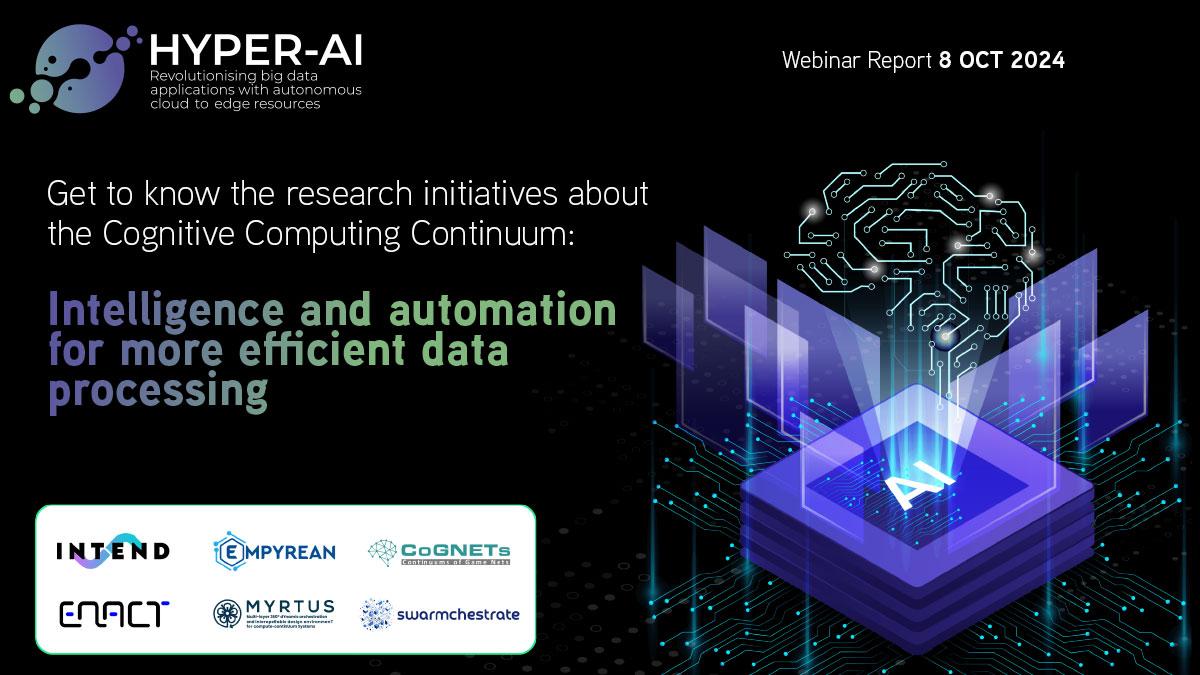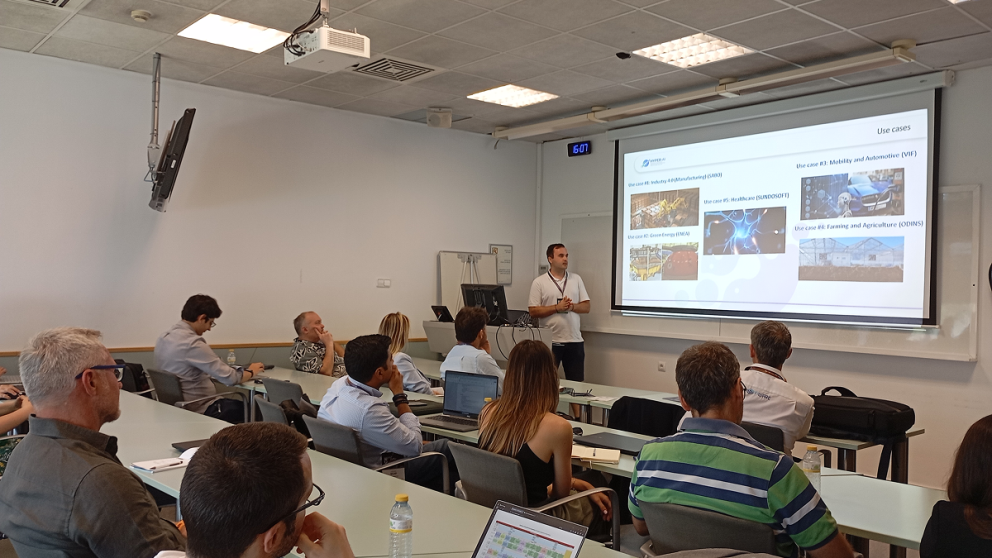Get to know the research initiatives about the Cognitive Computing Continuum - Webinar Report
12, November, 2024
·5 minutes read
·

Introduction
On the morning of Tuesday 8th October 2024, seven projects under the HORIZON-CL4-2023-DATA-01 call marked the beginning of the synergistic Cognitive Computing Continuum cluster with a joint webinar, Intelligence and automation for more efficient data processing. The HYPER-AI Project hosted and coordinated the webinar, joined by MYRTUS, Swarmchestrate, ENACT, CoGNETs, EMPYREAN, and INTEND.
With over 100 registrants from the EU and beyond, and an introduction from 2 European Commission officers, the event successfully highlighted the common research directions and challenges between the projects, setting a definitive precedent for future collaboration.
Background on the Cognitive Computing Continuum
Emiliano Corà, HaDEA Project Officer for HYPER-AI and Swarmchestrate, and Ana Juan Ferrer, DG CNECT Project Officer, jointly introduced the webinar by providing their insight on the creation of the Cognitive Computing Continuum Cluster.
Corà highlighted the importance of synergies among European-funded projects, remarking on the opportunities that they can provide for projects to share ideas for cooperation towards addressing call topics together.
Next, Juan Ferrer explained how years of work on compute and data management across the cloud resulted in a computing continuum. With the work now undertaken by the Cognitive Computing Continuum Cluster, the continuum becomes “cognitive” through AI integration.
These “cognitive” AI abilities will bring benefits across the entire cloud-edge continuum, through results jointly envisioned by the cluster project goals, such as:
- Automation and optimisation of resource and data management.
- End-to-end security management.
- The integration of heterogeneous devices and architectures to create distributed processing and storage resources.
- Energy efficiency.
- Infrastructure orchestration.
Overview of the cluster
Each project gave an overview of its goals, technologies, use cases and pilots, characterising the cluster as a whole.
- HYPER-AI
Goal: Develop a hyper-distributed platform for managing resources across the computing continuum, to improve the performance of data-intensive applications.
Technologies:
- Distributed ledgers for trust
- Decentralised architecture for reliability
- Standards-based semantic representations for interoperability
- Autonomous orchestration for efficiency, enabled by integrating specialised AI models
Use cases/pilots:
- Industry 4.0 (manufacturing)
- Green energy
- Mobility & Automotive
- Farming & Agriculture
- Healthcare
Impacts:
- Wider and more effective use of data:
- Social, scientific, and economic benefits
- Readiness for urgent challenges
- Improved European leadership
- Digital sovereignty and improved computing infrastructure
- INTEND
Goal: Build Generative AI agents with human-like intelligence to manage data pipelines in the cloud-edge computing continuum, based on the user’s intents.
Technologies:
- Decentralised data inputs, for strategic decision-making
- LLM-powered multi-agents, to make data operation decisions
- User-facing AI chatbot, for intent interpretation as input, and explainability for user
- Intent-based networking, orchestration, and storage management
Use cases/pilots:
- GreenStream: Intent-aware green video streaming
- MachineTalks: Chat-based operation of machine data analytics platform
- 5G4Data: Customer-oriented 5G data infrastructure
- iDataSpace: Intent-aware urban data space
- FedRobots: Context-aware adaptive federated learning pipelines on robots
Impacts:
- Open source tools and platform, enabling novel and efficient data usage
- Reduced environmental footprint of data processing
- Contribution to EU’s strategic autonomy in data and AIion content.
- EMPYREAN
Goal: Build federations of autonomous entities called Associations, which form decentralised, secure execution environments, sharing workload while managing resources independently.
Technologies:- Distributed ledger technologies and policy-based encryption techniques
- Secure edge storage
- Decentralized and distributed interconnection and data distribution service
- FPGA RDMA in edge nodes
- Cross-platform and Lightweight Container Packaging
- Decentralized Intelligence and AI-enabled Application Development and Deployment
Use cases/pilots:
- Advanced manufacturing
- Smart agriculture
- Warehouse automation
Impacts:
- Digital sovereignty: increased choice of data processing and storage for European entities
- Promotion of strategic industrial cooperation in AI- and ML-based data storage and processing
- Portable and interoperable software for decentralised computing Associations open to ecosystem
- ENACT
Goal: Develop a framework for energy-efficient adaptive scheduling and deployment of data-intensive workloads running on the Cloud-Edge computing continuum.
Technologies:
- AI Optimisers, for workload modelling, performance analysis, prediction and decision-making
- AI-powered container orchestrator, for optimally deploying and managing applications across distributed environments
- Zero-touch provisioning, for automatic setup and deployment of systems
Use cases/pilots:
- Hyper-Distributed Data Processing for Fujitsu’s Mobility Digital Twin Initiative
- Distributed Media and Entertainment Content Management
- Production and Distribution of Media Content for Cultural Heritage and Tourism Sectors
Impacts:
- Tools and technologies to support European small and medium-sized enterprises (SMEs)
- Energy-aware data infrastructure to avoid an explosion in Europe’s ICT footprint
- Common standards and infrastructure for the computing continuum and data spaces
- MYRTUS
Goal: Develop the MIRTO cognitive engine for dynamic runtime orchestration, allowing real-time application deployment and management, and improved resource allocation at fog and edge levels of the computing continuum.
Technologies:
- Swarm intelligence for decentralised resource allocation, based on real-time data;
- Federated learning for decentralised continuously optimised control;
- Design security support based on threat-modelling and automatic code generation for security countermeasures, to anticipate and allow risk management at runtime
Use cases/pilots:
- Mobility safety
- Healthcare
Impacts:
- Reusable, reconfigurable logic underpinning the MIRTO cognitive engine, to avoid long-term obsolescence of the technologies
- Improved data processing closer to end-users and devices
- A reference infrastructure for distributed applications across the computing continuum
- Swarmchestrate
Goal: Enable application-level, Swarm-based orchestration across the Cloud-Edge computing continuum
Technologies:
- Deployment framework for applications, consisting of microservices, constraints, Quality of Service goals, and other optional criteria, to enable them to self-coordinate
- Decentralised orchestration space consisting of swarms of heterogeneous resources, forming dynamic application spaces
- Decentralised ledger systems and identity management for application security
Use cases/pilots:
- Flood prevention
- Parking space management
- A digital twin of the natural habitat
- City environment management
Impacts:
- Reduced energy consumption and environmental footprint of hyper-distributed applications
- Optimised deployment and execution of hyper-distributed applications in any scenario beyond the demonstrator use cases.
- CoGNETS
Goal: Develop a “Continuum of Game NETS”, whereby devices across the continuum autonomously self-organise into swarms for data processing and service provisioning, according to game-theoretic principles.
Technologies:
- Middleware framework
- Swarm continuums
- Asymmetric, multi-player competitive game logic
Use cases/pilots:
- Manufacturing: efficiency in smart manufacturing environments
- Mobility: for autonomous or connected vehicle ecosystems
- Health: virtual hospitals
Impacts:
- Supports EU strategies, including the: EU Strategic Foresight Report, the EU strategy for Data, and the Digital Agenda for Europe.
- Business-friendly software tools
- Best practices for efficient, secure data processing
Common Goals and Distinctions
During the panel discussion, 4 main themes emerged for meaningful dialogue and comparison between the projects.
Each project described a distinct approach to ensuring security and scalability. Among these solutions were distributed ledgers, blockchain, zero-touch provisioning, and real-time threat modelling to secure both the design and runtime stages. Swarm intelligence, while not a feature of every project’s design, was common to HYPER-AI, MYRTUS, and Swarmchestrate, while all of the projects included some considerations for standardisation and interoperability. Finally, the cluster as a whole was aligned on the importance of considering the European Green Deal, whether indirectly through improving processing and resource usage efficiency, or through use cases and pilots focused on energy and sustainability.
Future cluster activities
Following this first webinar, these 7 projects will continue advancing their research goals, maintaining long-term collaboration through research synergies. Future cluster webinars will continue the success of the first.
Thank you to all who joined and participated in this webinar, making this a productive start for the cluster’s work together. Make sure you follow the cluster to stay updated on future news and events from the projects!
